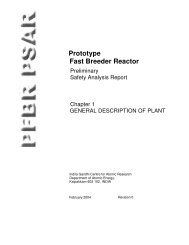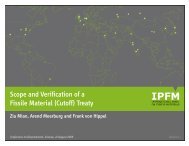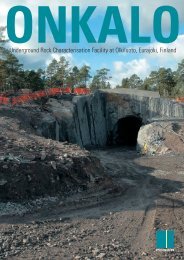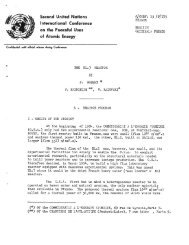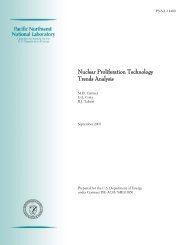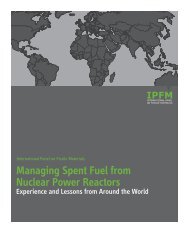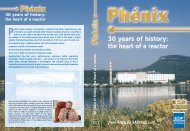Research Report No - International Panel on Fissile Materials
Research Report No - International Panel on Fissile Materials
Research Report No - International Panel on Fissile Materials
You also want an ePaper? Increase the reach of your titles
YUMPU automatically turns print PDFs into web optimized ePapers that Google loves.
The “reactor-grade” plut<strong>on</strong>ium in the high burn up spent fuel being discharged by these<br />
reactors has a different mix of isotopes from weap<strong>on</strong> grade plut<strong>on</strong>ium. However, reactorgrade<br />
plut<strong>on</strong>ium can be used to make a nuclear explosive and, as menti<strong>on</strong>ed earlier, <strong>on</strong>e<br />
of India’s May 1998 nuclear tests is reported to have involved such material. 93<br />
An estimated 8 kg of reactor grade plut<strong>on</strong>ium would be required to make a simple<br />
nuclear weap<strong>on</strong>. 94 If this plut<strong>on</strong>ium is not put under safeguards, it could provide an<br />
arsenal of over 1300 weap<strong>on</strong>s.<br />
A comm<strong>on</strong>ly cited problem with the use of reactor grade plut<strong>on</strong>ium is the increased risk<br />
of a “fizzle yield”, where a premature initiati<strong>on</strong> of the fissi<strong>on</strong> chain reacti<strong>on</strong> by neutr<strong>on</strong>s<br />
emitted by fissi<strong>on</strong>ing of plut<strong>on</strong>ium-240 leads to pre-det<strong>on</strong>ati<strong>on</strong> of the weap<strong>on</strong> and an<br />
explosive yield <strong>on</strong>ly a few percent of the design value. In Indian PHWR spent fuel,<br />
plut<strong>on</strong>ium-240 is over 22% of the total plut<strong>on</strong>ium (compared to about 5% in weap<strong>on</strong><br />
grade plut<strong>on</strong>ium). 95 The greater abundance of plut<strong>on</strong>ium isotopes other than Pu-239 in<br />
reactor grade plut<strong>on</strong>ium also leads to increased heat generati<strong>on</strong> and radiati<strong>on</strong> from a mass<br />
of this material. However, these are not insuperable engineering difficulties.<br />
The U.S. Department of Energy has noted that “At the lowest level of sophisticati<strong>on</strong>, a<br />
potential proliferating state or sub-nati<strong>on</strong>al group using designs and technologies no more<br />
sophisticated than those used in first-generati<strong>on</strong> nuclear weap<strong>on</strong>s could build a nuclear<br />
weap<strong>on</strong> from reactor grade plut<strong>on</strong>ium that would have an assured, reliable yield of <strong>on</strong>e or<br />
a few kilot<strong>on</strong>s (and a probable yield significantly higher than that). At the other end of<br />
the spectrum, advanced nuclear weap<strong>on</strong> states such as the United States and Russia, using<br />
modern designs, could produce weap<strong>on</strong>s from reactor grade plut<strong>on</strong>ium having reliable<br />
explosive yields, weight, and other characteristics generally comparable to those of<br />
weap<strong>on</strong>s made from weap<strong>on</strong>s-grade plut<strong>on</strong>ium.” 96 India presumably falls somewhere in<br />
this spectrum.<br />
One ‘modern design’ feature that allows reactor grade plut<strong>on</strong>ium to be used for weap<strong>on</strong>s<br />
is ‘boosting’, in which a gas mixture of deuterium and tritium is introduced into the<br />
hollow core of an implosi<strong>on</strong> weap<strong>on</strong> just before it det<strong>on</strong>ates. 97 The fusi<strong>on</strong> reacti<strong>on</strong> that is<br />
triggered releases a large quantity of neutr<strong>on</strong>s, which are able in turn to initiate fissi<strong>on</strong><br />
more quickly in a larger mass of the fissile material than the normal chain reacti<strong>on</strong>. This<br />
serves to greatly increase the yield. Indian weap<strong>on</strong> designers claim to have tested a<br />
therm<strong>on</strong>uclear weap<strong>on</strong> with a boosted fissi<strong>on</strong> primary in 1998. 98 One history of India’s<br />
nuclear weap<strong>on</strong>s program notes explicitly the use of boosting in a reactor grade<br />
plut<strong>on</strong>ium device test in 1998 and observes that “if validated it would increase India’s<br />
stock of fissile material dramatically.” 99<br />
The fast breeder reactor program<br />
India’s Department of Atomic Energy has c<strong>on</strong>sistently offered the potential shortage of<br />
domestic uranium and India’s abundant thorium reserves as the justificati<strong>on</strong> for its<br />
plut<strong>on</strong>ium fuelled fast breeder reactor program. India would gain access to the<br />
internati<strong>on</strong>al uranium market as part of the agreement with the United States and so end<br />
the prospect of future uranium shortages.<br />
22



